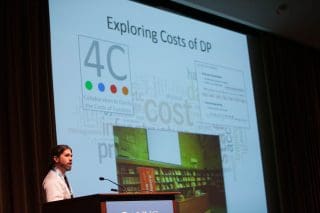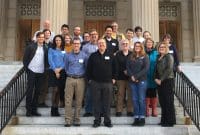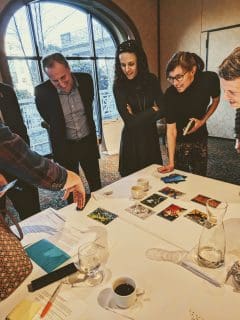
November 7, 2018
Community Cultivation, Revisited
By Hilary Faith HickmanI actually tried to stand in the way of Educopia’s founding!
I’m the first to admit it. A dozen years ago, I was the naysayer. I really didn’t think we could sustain a nonprofit organization centered on the science of community and collaboration.
I didn’t lack conviction that our field needed a more rigorous, structured approach to community building. My work was already grounded in the theories and applications of collective action, and my co-founders and I were testing a strong community facilitation model at that time. I had witnessed firsthand the way this model impacted the long-term success and cohesion of our own collaborative initiatives.
But developing an entire organization to advance collaboration within and between libraries, archives, museums, and publishers? It was a long shot, or at least so it seemed to me.
Thankfully, my co-founders, Dr. Martin Halbert, Tyler Walters, David Seaman, Greg Crane, and Rachael Bower, stood their ground. They convinced me that our vision had depth and substance, and this new, nonprofit organization could offer community-led efforts in our field the support they needed to grow and thrive.
Powered today by 20/20 hindsight, I can see they were absolutely right.
All of Educopia’s founders had directed successful grant collaborations and had witnessed, firsthand, the “Valley of Death” that stretches out in front of great projects once grant funding ends. We knew that most project directors, through no fault of their own, lacked the specific community- and organization-building skills required to successfully navigate across that Valley. The guidance and training through which project directors could gain those essential skills were missing from our field.

It was in that Valley that we saw an opportunity to help, an opportunity to provide administrative and technical scaffolding for community networks serving libraries, archives, museums, and scholarly publishers. We hoped that through our work, the “Valley” might start to seem a little less vast… and that it would become a lot less deadly for strong projects and programs.
We surveyed the landscape and found no other nonprofits serving libraries, archives, museums, and publishers in that capacity. We talked with organizations with kindred missions to make sure we weren’t duplicating existing efforts, but found none that delivered services in this area.
So…we incorporated. We filed for 501c3 status. Educopia Institute was born.
We began to offer services and training opportunities designed to bolster promising collaborative efforts and help communities of practice successfully transition from project-based efforts to sustainable programs. We built and refined tools to guide a community’s recognition of and response to growth or transition. We created growth maps to help communities identify concrete activities to undertake at specific development moments, and assessment tools to help them track their progress toward goals.
From the start, our work has not been something we offer to communities, but rather has been something we embed within communities. We empower the leaders of each program, service, or movement with the tools and skills they need in order to give each community the best possible chance of having staying power, not just while it’s connected to Educopia, but throughout its lifespan.

One of the things I love about looking back at our creation moment is seeing how well we’ve grown into our original vision. Today, Educopia provides a strong “backbone” for a broad range of communities, including those we host (BitCurator Consortium, Library Publishing Coalition, MetaArchive Cooperative) and the many others that have tapped into our consulting expertise over the last dozen years (Software Preservation Network, National Digital Stewardship Alliance, British Columbia Digital Library, Council of Prairie and Pacific University Libraries, Coalition to Advance Learning, and more).

Today, I am amazed at the accomplishments of the communities with whom we’ve worked. However, I am most proud of our recent efforts to distill and share the community cultivation framework that we’ve been using and refining for years. We have long wanted it to be available to communities (broadly defined) that need scaffolding, including those that are in early formation stages where resources are extremely tight. In the past, those communities often have needed the tools and techniques Educopia has built, but they didn’t have access to them unless they come to us as a client.
No longer!
Based on more than a decade of work and dozens of community-building experiences, Community Cultivation – A Field Guide, provides a powerful lens that can provide both emerging and established communities with ways to understand, evaluate, and plan their own growth, change, and maturation. We are offering this Field Guide freely in the hope that it will empower more community facilitators and leaders to invest in the health and sustainability of their own collaborative networks.
We hope the Field Guide will be of use to many communities in our landscape. If you would like more information or to talk about the Field Guide, please reach out to me anytime (katherine@educopia.org).